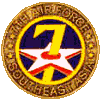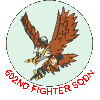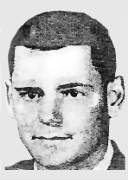Robert Franklin CoadyMajor602ND SOS, 56TH SOW (NAKON PHANOM RTAFB), 7TH AF United States Air Force 11 September 1939 - 26 July 1974 New Orleans, Louisiana Panel 34W Line 031 |
  
|
  
|
The database page for Robert Franklin Coady
|
Robert F Coady's name is on the POW/MIA bracelet I wore through high school and beyond. My e-mail address is below in case any of his family would like to have the bracelet.
Laura Young, |
|
I have worn this bracelet for a number of years, as did my mother before me. I hope and pray for his family and hope that he is either alive and well, or in a better place where there is no pain, suffering, and war. If anyone has any information about this man, please let me know. To all the veterans of each and every war who fought for our freedom, thank you. From the bottom of my heart, thank you.
Judson Dickinson |
|
Capt. Robert F. Coady I have worn his MIA bracelet since 1972 and am willing to return it to a family member. |
|
I knew Bobby when I dated his sister in 1962. He was a great guy and I'm sorry for his loss.
From a friend, |
Notes from The Virtual WallAt 0523 hours on 18 January 1969, then Captain Robert F. Coady was the pilot of an A1H Skyraider, call sign "Sandy 10," that departed Nakhon Phanom as the #2 aircraft in a flight of two. Capt. Coady was operating as the low element in a high/low flight formation conducting a first light search and recovery (SAR) mission to pick up the 2-man crew of "Stormy 02," an F-4D that was shot down the afternoon before. The Phantom crew was attacking an active 37mm anti-aircraft artillery (AAA) site when it was struck by AAA fire from that gun emplacement. Their target was located in rugged jungle covered mountains approximately 23 miles west-northwest of Khe Sanh, South Vietnam; 3 miles southeast of Muang Xepon, and 7 miles west of Tchepone, Savannakhet Province, Laos.At 0625 hours on 18 January, the co-pilot of Stormy 02 made radio contact with Sandy flight. Because of clouds and fog over the survivor's position, the rescue operation was delayed until 0900 hours. By that time the weather cleared with only a few scattered clouds left and visibility of 7 miles. After Sandy 09 and Sandy 10 made their first pass over his location, Lt. Fegan, the downed co-pilot, advised the Sandy pilots that there was automatic weapons fire coming from the east and southeast of him. Further, repeated weapons fire was noted on each subsequent pass over the survivor's position. Sandy 09 received 7 hits from small arms fire. Capt. Coady was working the same area and at the same altitude as the flight leader, and was probably hit at the same time by the same gunners. According to Sandy 09, at 0932 hours he heard an unidentified radio call saying, "What in the world is that?" Looking around while pulling off the target, Sandy 09 observed a dust cloud, a white phosphorous cloud and smoke from burning gasoline. The entire length from dust to smoke was approximately 125 yards. The dust cloud from the crash path was located in a small jungle clearing that then penetrated the jungle growth from an easterly heading. Sandy 09 saw the aircraft wreckage approximately 5 miles southeast of Muang Xepon and 5 ½ miles west of Tchepone. However, he saw no parachute in the confusion, dust and smoke. He tried to raise Capt. Coady on the radio, but was not able to establish contact. SAR efforts continued throughout the day, but when no trace of Robert Coady was found he was immediately listed Missing in Action. During the search operation, Lt. Fegan was rescued by a SAR helicopter. The pilot of the Phantom, Capt. Victor A. Smith, was not located and subsequently he was also listed Missing in Action.
From In July 1992 Captain Coady's crash site was investigated by a joint U.S./Vietnamese team and the team interviewed witnesses concerning the circumstances of the crash. One source described having recovered Coady's dog tag and other personal artifacts in 1990 while scavenging for metal at the crash site. During July 1992 personal artifacts and surface wreckage recovered permitted a tentative correlation of the site to Captain Coady's aircraft crash site. The recovered material also suggested Captain Coady did not exit his aircraft before it crashed.
From the 30 July 2004 Remains believed to be those of Major Coady were repatriated on 10 Feb 1994. Positive identification was announced by the government on 28 Nov 2001. A memorial stone had been placed in Arlington National Cemetery before Major Coady's recovery, but it is not certain that his remains were buried there. Captain Victor Smith's remains have not been recovered. NOTE:The A-1 Skyraider was designed for the Navy during World War II and brought into Fleet service immediately after the end of the war. Twenty years later, the Skyraider served the Navy and Air Force faithfully throughout the war in Southeast Asia. Its ability to carry a wide range of ordnance (8,000 pounds of external armament, internal cannons), great flight range and endurance, and its ability to absorb punishment made the Skyraider one of the premier performers in the close air support, attack, and RESCAP mission role. Everyone who flew over Laos and the adjoining areas of both Vietnams knew of and relied on the Sandy SAR pilots, who flew out of Nakhon Phanom RTAFB, Thailand.
- K J Davis, Commander, USN (Ret) |
|
The point-of-contact for this memorial is one who wears his MIA bracelet, Laura Young loorah@aol.com |
|
Top of Page
www.VirtualWall.org Back to |
With all respect
Jim Schueckler, former CW2, US Army
Ken Davis, Commander, United States Navy (Ret)
Memorial first published on 29 Oct 2000
Last updated 06/24/2006